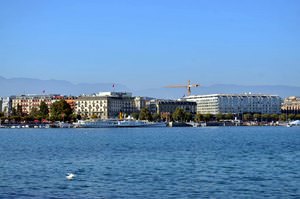 The landmarks of Geneva are not limited to the presented 6 architectural sights. A curious traveler will find thousands of exciting places here. However, below we present the most impressive and striking architectural sights of Geneva, which should be noted at first - St. Pierre Cathedral, Musee Ariana, Red Cross Museum, Synagogue Beth-Yaacov, Russian Church of Geneva and many others. In this unusual virtual tour, you will see the photos and read the facts on each monument. But, most importantly, you will be able to fly over each landmark, and to see the whole architectural ensemble of Geneva in 3D format from the sky.
The landmarks of Geneva are not limited to the presented 6 architectural sights. A curious traveler will find thousands of exciting places here. However, below we present the most impressive and striking architectural sights of Geneva, which should be noted at first - St. Pierre Cathedral, Musee Ariana, Red Cross Museum, Synagogue Beth-Yaacov, Russian Church of Geneva and many others. In this unusual virtual tour, you will see the photos and read the facts on each monument. But, most importantly, you will be able to fly over each landmark, and to see the whole architectural ensemble of Geneva in 3D format from the sky.
St. Pierre Cathedral, Geneva
Location on the map:  Facts:
Facts:
» The cathedral built at the beginning of the 13th century combines many architectural styles but looks like a single unit. » Its interior features some austerity, modesty and, and strictness.
» Here, you can such unique item, as the rich chair of the French theologian Jean Calvin.
» You can also climb up the tower. The path in one place offers two directions, southern and northern. The northern tower with a high spire has a panoramic view of the city, as the building is located in its center, on the hilltop, 404 m above sea level.
» On the right side, there is a gravestone in honor of French Protestants (1889).
» You should also visit the Archeology Museum behind the cathedral. Here, you can see some fragments of the old building found during the excavations. As the archeologists believe, they date back to the 4th century.
» In December, the three-day historical holiday is celebrated in front of St. Pierre Cathedral. Mummers dance and a huge fire is started at this time.
» When it gets dark, the building is illuminated with spotlights.
» In the cathedral, the Geneva Bible was translated from Latin to English for the first time.
Musee Ariana, Geneva
Location on the map:  Facts:
Facts:
» Ariana was the name of collector Gustave Revilliod known in his circles. The museum is named after her according to his will. » His private collection includes over 5 thousand items. In the late 19th century, the collector exhibited them.
» In the museum, there is a workshop for repairing glass items.
» The Musee Ariana is famous for the collection of glass and ceramic exhibits (there are over 20 thousands of them). Patterns and inscriptions on the glass surface, as well as the unusual shape of exhibits, are very impressive.
» The Musee Ariana is located in the palace with a glass dome, in the cedar park.
» The guide will explain the origin of any exhibit. On display, you can see tea and coffee sets, and dinnerware the Royal Family used. There are also clay items made in the Middle Ages. You can learn how pottery originated and what tools for glass-painting were used.
» You can also see glass toys, porcelain zips and pens, clay amulets, and crystal lamps.
» In the museum, there are 20 separate rooms, each of which displays particular items depending on the epoch.
Red Cross Museum, Geneva
Location on the map:  Facts:
Facts:
» The collection of the International Red Cross Museum contains exhibits from ancient times to the present day. » The building is located in the territory of the head office of the namesake organization.
» Collected items, pictures and videos symbolize the role of the Red Cross helping people in post-conflict and post-disaster situations.
» Showrooms are divided into separate sections. One of the rooms presents information about the organization’s activity in all corners of the world.
» The huge interactive globe shows where rescues work today.
» The exhibition is aimed at awakening sympathy for people in trouble and calling on the citizens to contribute modestly to the humanitarian activity.
» The idea of creating the Committee of the Voluntarism Organization was brought to life by the Swiss Henri Dunant in 1863. He was impressed by the human suffering. Volunteers from many countries supported him. As a consequence, the movement has become an international undertaking.
» Now, the number of volunteers is about 100 million. The International Red Cross and Red Crescent Movement received the Nobel Prize for its merits three times.
Synagogue Beth-Yaacov, Geneva
Location on the map:  Facts:
Facts:
» The Jewish community settled in Geneva at the beginning of the 19th century. » Its house of worship is called the Beth Yaakov Synagogue. It was built in 1859.
» The exterior of the building reminds of the origin of Jews with its style. The construction gained a historical status in 1995.
» The octagonal dome covers the main building. Gray walls are decorated with white and pink inserts in the form of straight lines. You can see the inscription above the horseshoe-shaped arched double doors.
» There is a separate room in the upper gallery for praying women.
» The Beth Yaakov Synagogue is the first construction in the territory of the city permitted by the authorities. Beth Yaakov is the Hebrew name translated as “the house of Yaakov”. Yaakov was the Biblical Patriarch.
» In the chapel, there is a two-tier box with sacred writings. It is surrounded by white arches. People pray opposite the box.
» There is an altar in the center of the room. There is a special table for reading scrolls on it.
» The Beth Yaakov Synagogue is a cult construction and the historical attraction of Switzerland, as its architectural style is unusual.
» The main hall is intended for prayers. The Greek word “synagogue” is translated as “the gathering of people”.
Russian Church of Geneva, Geneva
Facts: » Such significant events, as the wedding of the Russian artist Vrubel and the famous singer Zabela and the baptism of F. Dostoevsky, took place in the church.
» The cathedral was blessed in 1866.
» ₣280 000 was spent on the building construction.
» Gilded domes and the chapel with a belfry of 5 bells are really impressive. The church was built of white stone from the Swiss Mountains. The ledge has the shape of a notched curve. The upper part is five gilded domes. The building resembles an elongated cross with a semicircular altar. The facade is made of gray marble. Above the front arched doors, you can see pictures of saint dukes and images of Alexander Nevsky and Venerable Sergius of Radonezh.
» The ceiling inside is decorated with the image of Christ in the midst of the sky and golden stars. It is framed with silhouettes of seraphs. The walls are decorated with painted golden crosses in green ovals. Stained glass has the shape of crosses of stars on clouds. You can see praying Christ on the altar. Behind it, there is a staircase to the basement of the church.
Water-Jet, Geneva
Facts: » The fountain in Geneva lifts water jets up to 140 meters of height, which is the same as a 46-storey building. It is the fountain with the most powerful water jets in the world.
» When the jets get up, they have a different shape, for example, the water cylinder or the fan of splashes.
» The wind and sunlight change the color of the water from pink to silver and blue.
» When it gets dark, the complex is illuminated with colorful lights.
» Despite the fact that it is located in the city center, it is in the center of the lake.
» Initially, in 1886, the fountain served as a “pump” that ensured the uninterrupted water supply.
» The fountain never stops. For safety reasons, it is switched off at low temperatures or if the wind is too strong.
» The water speed mode is 200 km/h. Two powerful units pump 500 l of water every second. The water rising up weighs 7 000 kg. One small drop goes down after the 16-second flight.
» The water in the lake is dark. The liquid in the fountain is transparent due to special devices that saturate jets with the air.
» The taste of the lake water is estimated every year. You can also acquaint with the inner structure of the unit.







